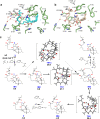AvmM catalyses macrocyclization through dehydration/Michael-type addition in alchivemycin A biosynthesis
- PMID: 35922406
- PMCID: PMC9349299
- DOI: 10.1038/s41467-022-32088-4
AvmM catalyses macrocyclization through dehydration/Michael-type addition in alchivemycin A biosynthesis
Abstract
Macrocyclization is an important process that affords morphed scaffold in biosynthesis of bioactive natural products. Nature has adapted diverse biosynthetic strategies to form macrocycles. In this work, we report the identification and characterization of a small enzyme AvmM that can catalyze the construction of a 16-membered macrocyclic ring in the biosynthesis of alchivemycin A (1). We show through in vivo gene deletion, in vitro biochemical assay and isotope labelling experiments that AvmM catalyzes tandem dehydration and Michael-type addition to generate the core scaffold of 1. Mechanistic studies by crystallography, DFT calculations and MD simulations of AvmM reveal that the reactions are achieved with assistance from the special tenuazonic acid like moiety of substrate. Our results thus uncover an uncharacterized macrocyclization strategy in natural product biosynthesis.
© 2022. The Author(s).
Conflict of interest statement
The authors declare no competing interests.
Figures





Similar articles
-
Tandem Macrolactone Synthesis: Total Synthesis of (-)-Exiguolide by a Macrocyclization/Transannular Pyran Cyclization Strategy.Angew Chem Int Ed Engl. 2022 May 23;61(22):e202202549. doi: 10.1002/anie.202202549. Epub 2022 Mar 16. Angew Chem Int Ed Engl. 2022. PMID: 35243740
-
Lessons from Natural Product Total Synthesis: Macrocyclization and Postcyclization Strategies.Acc Chem Res. 2021 Feb 16;54(4):861-874. doi: 10.1021/acs.accounts.0c00759. Epub 2021 Jan 28. Acc Chem Res. 2021. PMID: 33507727 Free PMC article.
-
Heck Macrocyclization in Forging Non-Natural Large Rings including Macrocyclic Drugs.Int J Mol Sci. 2023 May 4;24(9):8252. doi: 10.3390/ijms24098252. Int J Mol Sci. 2023. PMID: 37175956 Free PMC article. Review.
-
A multicomponent macrocyclization strategy to natural product-like cyclic lipopeptides: synthesis and anticancer evaluation of surfactin and mycosubtilin analogues.Org Biomol Chem. 2017 May 3;15(17):3628-3637. doi: 10.1039/c7ob00459a. Org Biomol Chem. 2017. PMID: 28406518
-
Macrocyclization by ring-closing metathesis in the total synthesis of natural products: reaction conditions and limitations.Angew Chem Int Ed Engl. 2006 Sep 18;45(37):6086-101. doi: 10.1002/anie.200600641. Angew Chem Int Ed Engl. 2006. PMID: 16921569 Review.
Cited by
-
Development of a drug discovery approach from microbes with a special focus on isolation sources and taxonomy.J Antibiot (Tokyo). 2023 Jul;76(7):365-383. doi: 10.1038/s41429-023-00625-y. Epub 2023 May 15. J Antibiot (Tokyo). 2023. PMID: 37188757 Review.
-
Intramolecular C-C Bond Formation Links Anthraquinone and Enediyne Scaffolds in Tiancimycin Biosynthesis.J Am Chem Soc. 2022 Nov 9;144(44):20452-20462. doi: 10.1021/jacs.2c08957. Epub 2022 Oct 24. J Am Chem Soc. 2022. PMID: 36279548 Free PMC article.
-
High-throughput prediction of enzyme promiscuity based on substrate-product pairs.Brief Bioinform. 2024 Jan 22;25(2):bbae089. doi: 10.1093/bib/bbae089. Brief Bioinform. 2024. PMID: 38487850 Free PMC article.
-
Mutagenetic analysis of the biosynthetic pathway of tetramate bripiodionen bearing 3-(2H-pyran-2-ylidene)pyrrolidine-2,4-dione skeleton.Microb Cell Fact. 2024 Mar 21;23(1):87. doi: 10.1186/s12934-024-02364-7. Microb Cell Fact. 2024. PMID: 38515152 Free PMC article.
References
-
- Nicolaou, K. C., Montagnon, T. Molecules that changed the world. Wiley-VCH: Weinheim 2008.
Publication types
MeSH terms
Substances
LinkOut - more resources
Full Text Sources
Medical

